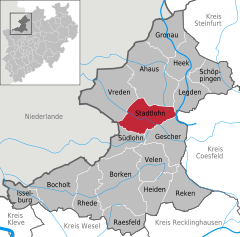Stadtlohn
| Stadtlohn | |||
|---|---|---|---|
|
| |||
| |||
 Stadtlohn | |||
Location of Stadtlohn within Borken district 
 | |||
| Coordinates: 51°59′33″N 06°54′54″E / 51.99250°N 6.91500°ECoordinates: 51°59′33″N 06°54′54″E / 51.99250°N 6.91500°E | |||
| Country | Germany | ||
| State | North Rhine-Westphalia | ||
| District | Borken | ||
| Government | |||
| • Mayor | Helmut Könning (CDU) | ||
| Area | |||
| • Total | 79.06 km2 (30.53 sq mi) | ||
| Population (2015-12-31)[1] | |||
| • Total | 20,411 | ||
| • Density | 260/km2 (670/sq mi) | ||
| Time zone | CET/CEST (UTC+1/+2) | ||
| Postal codes | 48703 | ||
| Dialling codes | 0 25 63 | ||
| Vehicle registration | BOR | ||
| Website | www.stadtlohn.de | ||
Stadtlohn is a town in the north-west of North Rhine-Westphalia, Germany, part of the district Borken. The Berkel river flows through it on its way to the Netherlands.
Geography
Division of the town
Stadtlohn consists of 9 districts:
- Almsick
- Büren
- Estern
- Hengeler
- Hordt
- Hundewick
- Stadtlohn
- Wendfeld
- Wenningfeld
History
The town was founded as Lohn by Liudger, the first Bishop of Münster about the year 800. About 985 Gescher was split form Lohn, which in turn (1231) split into Südlohn (literally "South-Lohn") and Nordlohn (literally "North-Lohn"). The name Stadtlohn (literally "Town-Lohn") is first mentioned in 1389 after the small town Nordlohn was secured by a moat, a defensive wall and gates and gained the town rights. About 1406 Stadtlohn was burned down by Count Heinrich I of Solms-Ottenstein because he feuded with the bishop of Münster. Bishop Heinrich III of Münster verified its town rights in 1491.
In 1584 Stadtlohn was pillaged by the troops of Duke Ernest of Bavaria and again in 1588 by Dutch soldiers. In 1591 Spanish soldiers attacked the town. For a few months of 1598 Spanish troops were stationed in the town during the Eighty Years' War. In 1611 a serious fire destroyed 225 of 235 houses.
On August 6, 1623 during the Thirty Years' War the Battle of Stadtlohn (German: Schlacht im Lohner Brook) saw Johan Tzerclaes, Count of Tilly's imperial troops victorious over Duke Christian of Brunswick's men. About 6.000 soldiers died that day. In 1742 regular pilgrimages started to a statue of Mary in a small chapel in Stadtlohn form various towns in the Münsterland. The adoration of the virgin Mary ended in 1886 when the statue was stolen from the Hilgenbergchapel.
In World War II, Stadtlohn was hit by bombs as early as 1940 and 1942, but the damage was limited. In March 1945, however, Stadtlohn was affected by two massive allied airstrikes that destroyed 86% of the town. About 600 inhabitants lost their lives. On March 31, 1945 British forces marched into the town.
Sights
- Former Jewish Cemetery in the town center. Close by there is a sightworthy commemorative plaque in Hagenstrasse street reminding on the synagogue which was destroyed in 1938.
- Former pilgrimage chapel Marienkapelle on Hilgenberg hill.
- Saint Otger Church, rebuilt after the war.
- Town Hall, destroyed in 1945 and rebuilt in 1953.
- Hünenburg
- Dicke Eiche
Museums
- Railroadmuseum Stadtlohn
- SIKU Toy-car Museum
Sports clubs
- DJK Eintracht Stadtlohn
- SuS Stadtlohn
International relations
Stadtlohn is twinned with:
-
 Weerselo, Netherlands
Weerselo, Netherlands -
 San Vito al Tagliamento, Italy
San Vito al Tagliamento, Italy -
 Altlandsberg, Germany
Altlandsberg, Germany
Notable persons
- Bernhard Rothmann a Reformer and an Anabaptist leader
- Church: Sankt Otger Kirche
- Former pilgrimage chapel Marienkapelle.
 Former Jewish Cemetery.
Former Jewish Cemetery. Commemorative plaque reminding on the synagogue.
Commemorative plaque reminding on the synagogue. Lohn family crest
Lohn family crest
References
- ↑ "Amtliche Bevölkerungszahlen". Landesbetrieb Information und Technik NRW (in German). 18 July 2016.
External links
| Wikimedia Commons has media related to Stadtlohn. |
- Official site (German)
- Detailed map of Stadtlohn, including pictures (German)

